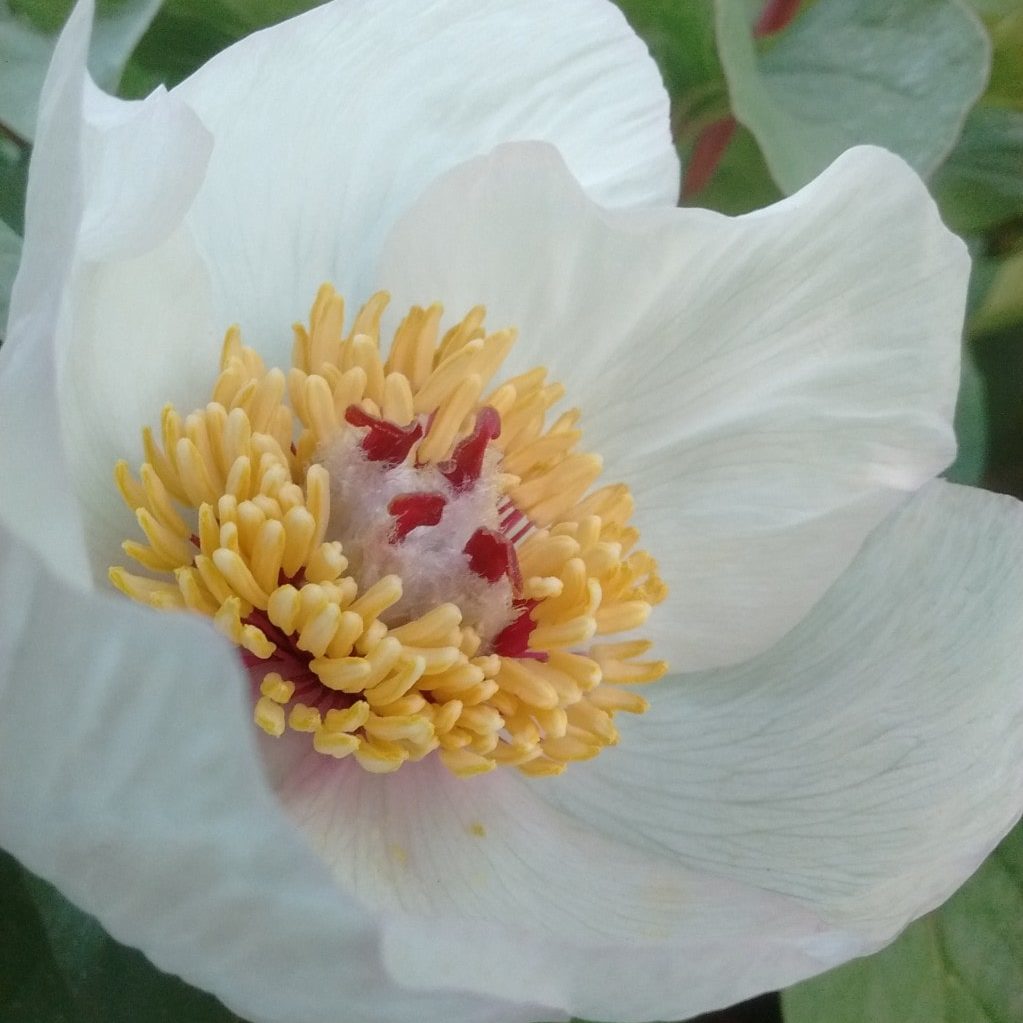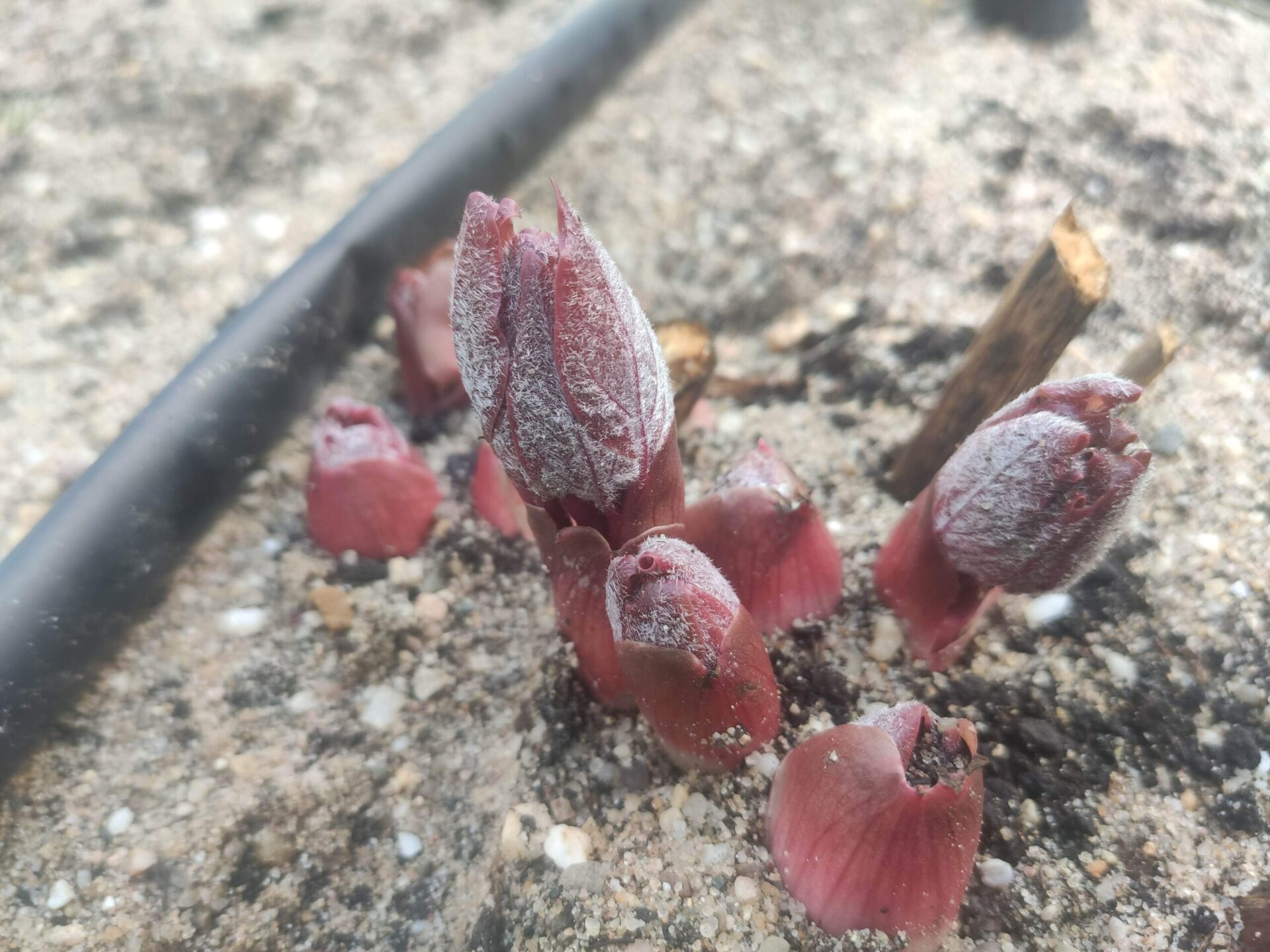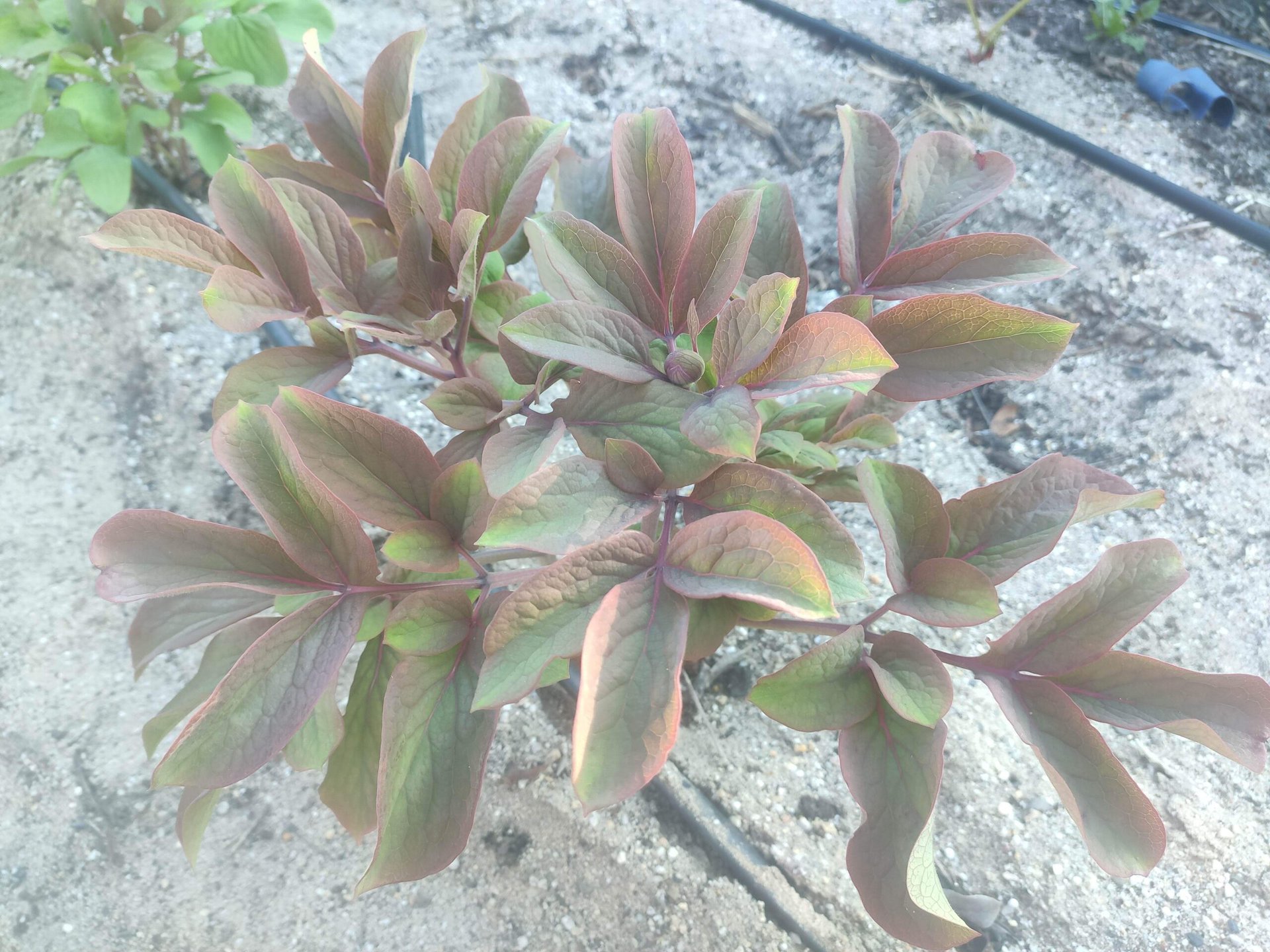khurtekant posted in the group Species Peonies International Network (SPIN)
These are some open pollinated seedlings from Lagodekhi Sunrise, a selection from those lagodechiana hybrids (mloko x caucasica), a natural hybrid which you’ll find in Georgia. They naturally grow in shade, but my seedlings are in full sun. This shows on the leaflets, they are turning into all kinds of colours. I quite like it in fact.
13 CommentsI can see you’re from Turkey. It has probably the most diverse natural collection of peony species of any country. P. peregrina, P. turcica, P. kesrouanensis, P. mascula ssp mascula, P. mascula ssp bodurii, P. arietina, P. tenuifolia, P. daurica ssp daurica, P. daurica ssp macrophylla, P. arietina ssp arasicola and P. x kayae (a hybrid). Perhaps…Read More
I am from the Caucasus, but I live in Turkey. I am stunned that Anatolia contains so, so many varieties. I will look them up, and, hopefully find and photograph them, even if others have done it before. A local Peony Pilgrimage, if you will, before I go to China and Japan. I am watching CGTN’s documentary The Peony 1-4, and my heart has fallen. I…Read More
This is probably the best article on peonies in Turkey, listing 11 (sub-)species in 54 locations in Turkey. It’s in Turkish but I suppose that will not be a problem for you.
Oh well, that’s very friendly, thank you. But I’ve run it through Google translate. The translation is very basic and it does happen that some sentences are rather incomprehensible, but it’s good enough to understand the main part. A translation from you would of course be far better, but I think the time needed to translate such a long article…Read More
Well, you surely can. Here’s a map showing where you can find wild peonies in Turkey. There are probably listings with more precise locations, but I’m sure if you look somewhat you can find them. Some people sometimes post images of wild Turkish peonies on facebook, you might have a look there as well and perhaps ask the photographers where they…Read More
Try joining this group on facebook and look for some images of Paeonia turcica, paeonia arietina, paeonia kesrouanensis and paeonia arietina arasicola. There have been images posted of those from Turkey in the last two years at least.
As much as I appreciate your assistance, I have a deep-rooted aversion to fB since the day they said, ‘We have discovered that you use your fb password on other sites’ back in 2008. I will never join them unless for commercial purposes. I will see what information I can get without joining fb. Much, much appreciated. I love peonies almost as much…Read More
Not that only species peonies grow in Turkey, here’s an instagram account of a commercial peony cut flower farm:
https://www.instagram.com/kesme_sakayik/
khurtekant wrote a new post
2 CommentsInteresting to see your results, and to see that you’ve gotten germination so quickly ! I’d be interested in knowing what your temperature routine was, and if you used this year’s seeds ?
I have my ways of doing it, but I can’t say that I’ve done as much experimenting as I should. I get results, so I’m happy, but since I’m getting something…I’m probably afraid to do too much experimenting out of fear I’ll get nothing.
And what about all those cracked seeds ? I get them with some crosses, but not others. ‘Laddie’ seems to be the worst offender here – some years a large percentage of seeds will be ruptured, while other years most of them look fine. In the past I used to think that it had to do with widely varying amounts of soil moisture, which may still be the case. But different pollens seem to produce different results too.
My sense is that when we get brown tips on the end of the roots, it’s from too much moisture or a lack of air ?
I’ve come to where I now give all of my seeds, fresh or not, several days of soaking prior to putting them in the bags. And will give them a bleach solution rinse before I bag them too. My sense is that if I’ve soaked my seeds well before I bag them, then all that’s really needed in the bags is an atmosphere that can maintain 100% humidity. I use fairly coarse vermiculite rather than the very fine stuff, but that’s just a matter of preference, along with what happens to be in the big 4 cubic foot bag that I buy every few years.
One other thing about vermiculite – it does a good job of showing you which seeds are rotting, by the manner that it sticks to rotting seeds.
In any case, good for you for doing these sorts of experiments. I suspect others may be like myself – we do something that seems to provide us (for better or worse) with results, and then we tend to stop experimenting.
@bobjohnson Yes, this year’s seeds. But they were mature halfway August, earlier than yours. Then soaked for two days and then all the different treatments. The bags were placed in my unheated greenhouse. I should have logged the temperatures perhaps, but I didn’t (I’ll do that next year). The greenhouse vents are set to keep temperatures around 21-23°C (68°-74°F), although temperatures may have risen above this at times. There was no heating however, so temperatures during night will have gone down quite a bit as well. Last year I did the same treatment, but temperatures were not as high then and rooting occurred later, although here as well I don’t remember exactly when.
I am not sure about the exact treatment as well. I did receive some seeds later in the season and hesitated what to do with them. Place them in the greenhouse as well, although with decreasing temperatures they may not receive a long enough warm treatment. Or place them inside in a room where I can give additional heating? I’ve split them, but as it’s only a few seeds, I doubt much can be concluded from it if I would get some roots.
What I also wonder about: in the greenhouse they actually receive both warm and cold during the ‘warm period’. That’s more like will happen in nature of course. I have noticed that some of the seeds already had a plumule growing. So those must already have received their required cold period as well. Perhaps it’s thus possible to give both warm and cold period at the same time? Which is not necessarily very beneficial of course, I cannot plant them outside as they risk being frozen resulting in early death. And for some I do think outside planting after the first roots might be better, in pots there is always more risk of loss is my experience.
But what I reallly wanted to say: what would be best? Continuous warm temperature (as you would have inside) or alternating warm/cold temperatures, with probably the warm daily temperatures rather warm enough and for a long enough time? There sure is some more experimenting to do. But it will be for next year… I didn’t really mind all the failed germinations from Just Peachy. If not for this experiment I would never have collected the seeds at all.
I think the brown tips at the growing point of the roots are from too much moisture. If it were lack of air, I’d expect it to see at random throughout the experiment, which wasn’t the case, it deteriorated with increasing moisture levels.
The ruptured seeds I threw away weren’t necessarily bad, but I wanted to rule out the possibility that they would influence the results if they germinated less well or otherwise compared to ‘normal seeds’.
khurtekant wrote a new post
3 CommentsCORRECTION. Please delete my previous translation:
Translation of the text found in: https://arastirma.tarimorman.gov.tr/yalovabahce/Menu/35/Sus-Bitkileri
Please comment with your corrections, as I am no botanist:
Top of Page:
(‘Alo’ Numbers for calling Social Services, Food Safety Line, Forest Fire Emergency Lines, Vision Impaired Link)Page Title:
Turkish Republic, Ministry of Agriculture and Forestry
Atatürk Garden Culture Central Research Institute DirectorateDecorative Plants
Being the first decorative plant to be developed in our natural resource-rich country, the Peony is currently being researched by our institute, and its breeding rights have been taken under protection.
Alev Topu: ‘Fireball’ [‘Flame Ball’]
This variety, being a hybrid of Paeonia peregrina, has multilayered red flowers, is scented and perennial. Blooms in the first week of May. Its segmented green leaves are also decorative. Its blooms are sterile in structure, and, having been observed to very rarely show a tendency to bear fruit, its production by seeding is not economically feasible. Instead, it is produced by root separation and tissue culture. When propagated by root separation, if blooms are expected of each piece of tuber root within the year, a tuber root must contain at least 3 offshoot eyes. The separation process can be realised every 3 to 4 years.
Eful
This variety, This variety, being a hybrid of Paeonia peregrina, has multilayered deep pink flowers, is very beautifully scented and perennial. Blooms in the first week of May. Its segmented green leaves are also decorative. Its blooms are sterile in structure, and, having been observed to very rarely show a tendency to bear fruit, its production by seeding is not economically feasible. Instead, it is produced by root separation and tissue culture. When propagated by root separation, if blooms are expected of each piece of tuber root within the year, a tuber root must contain at least 3 offshoot eyes. The separation process can be realised every 3 to 4 years.
Kaya [‘Rock’, Most likely a reference to Mr Erdal Kaya]
This variety, being chosen by selection methods from the population of the hybrid natural species of Paeonia x kayae, is deep pink – white variegated in colour, has single layered blooms, lightly scented and early bloomer. Blooms in the first week of April. Its tri-segmented oval green leaves and fruit that crack open in autumn are also quite decorative. Produces quite a lot of seeds, and, therefore, in addition to being able to be propagated by seeding, it can also be produced by separation and tissue culture. When produced by separation, if blooms are expected of each piece of tuber root within the year, the tuber roots must contain at least 3 offshoot eyes. The separation process can be realised every 3 to 4 years.
Tombak [‘Iranian Goblet Drum’]
Blooms in the first week of May. Its segmented green leaves are also decorative. Its blooms are sterile in structure, and, having been observed to very rarely show a tendency to bear fruit, its production by seeding is not economically feasible. Instead, it is produced by root separation and tissue culture. When propagated by root separation, if blooms are expected of each piece of tuber root within the year, a tuber root must contain at least 3 offshoot eyes. The separation process can be realised every 3 to 4 years.
Your previous translation was deleted as requested. The translation is good I think, thank you. It describes four of the varieties that have been introduced. Three of them hybrids with P. peregrina (what the other species or plants are is not being told, but the ‘segmented’ leaves surely come from P. peregrina) and one selection from P. x kayae. There are more varieties by now, but I singled out these two in the text simply because they had the clearest photographs. The descriptions are rather short, they describe the flower and flowering time, but length, floriferousness, sturdiness and so on are missing. Remarkably they also say ‘production by seedlings is not economically viable’ because the more double varieties hardly give any seed. I’m quite sure they must know that cultivars don’t come true from seed anyway, so even with lots of seeds it would not have been an option. P. kayae might be an option to multiply through seeds, if they are selfed you’ll still end up with the same species, but again: not the same cultivar plant, thus the resulting seedlings might as well be much more white or pink, be smaller or taller etcetera… I do wonder whether some growers already have these in their fields for either cut flowers or to sell as garden plants. The few images or information I can find from Turkish growers always show the standard lactiflora varieties which are grown all over the world.
Ready for Winter. Cut down with some 10 cm left as research has shown this results in the least amount of botrytis the following year. The precise drip irrigation is also showing nicely on this picture, only water where it’s needed. Halfway to end of December the plants will receive their GA3 treatment and the sides of the polytunnel will be…Read More
2 CommentsGA3 should be used before the begainning of peony’s dormancy, i.e, halfway to end of December in Belgium?
@lindapeony Not at the beginning. They need some natural cold, then after this you can shorten their cold requirements by giving the GA3 and if late enough and warm enough, they will start growing before they normally would. If you give it at the beginning of the cold period (which has already started no doubt with the colder nights) it will not…Read More
khurtekant posted in the group Species Peonies International Network (SPIN)
Root shapes from some well-grown species.
1. P. daurica ssp wittmanniana
2. P. mascula ssp bodurii
3. P. daurica ssp velebitensis
4. P. morisiikhurtekant posted in the group Species Peonies International Network (SPIN)
Paeonia daurica ssp daurica. Sometimes known as the ‘Crimean Peony’ (although there is also P. tenuifolia growing there). Old names P. triternata or even P. corallina triternata. According to Hong this species grows there but also in Turkey and westwards to former Yugoslavia. The Crimean version is known to have wavy leaflets (much more than my…Read More
3 Commentskhurtekant posted in the group Species Peonies International Network (SPIN)
Paeonia flavescens. From selfed seeds from a wild plant which originated in Sicily (around Palermo). Theoretically a synonym for either P. mascula russoi or P. mascula hellenica, and thus not officially recognized as a species itself, though there’s reason to believe it is. It resembles neither of those synonyms in fact. Looks most like mascula…Read More
1 Commentkhurtekant posted in the group Species Peonies International Network (SPIN)
Paeonia morisii from Sardinia (Sardegna). According to Hong a synonym for P. corsica, which is very variable. It might be argued that his classification of P. corsica is not completely perfect as there is a P. corsica on the island of Corsica which is different from this one and there is also P. sandrae on Sardinia which is different as well. And…Read More
1 CommentThe Peony Society posted in the group Species Peonies International Network (SPIN)
A first post in this new group about peony species. As I’ve used it as the cover image for this group it’s only fitting to start with this species: Paeonia velebitensis. Wild collected in Croatia, the Velebit Mountains, East of the city/village of Karlobag, which is the area from where the dried herbarium specimens originated that Hong De-Yuan…Read More
1 Commentkhurtekant posted in the group Species Peonies International Network (SPIN)
Paeonia kesrouanensis (or P. turcica depending on your views). Naturally growing along the eastern Mediterranean countries at higher elevations under some shadow from trees and shrubs. From south-eastern Turkey downwards to Syria and Lebanon. In southern and south-western Turkey the P. turcica, which is supposedly a synonym according to Hong, is…Read More
1 Comment- Load More Posts
Friends
MONA
@mona
Longyeong paeonia rockii
@longyeong
Dick
@dhoutenbos
Matt
@msnyderla
Jon
@jonr
Bernd
@bernd-sommer
Daniel
@danielbaker
Luriel
@goldenqueen
Alain
@phenix
Michele
@mmmoore
The Peony Society
@the-peony-society
Dick
@dick
khurtekant
@khurtekant
amy
@beckybecky312
Groups
Species Peonies International Network (SPIN)
Public Group


















































































:o So close! Did not know it grew in my Motherland. What DOES not grow in the Caucasus? I will look these up. Turkey’s Black Sea climate might accommodate them.